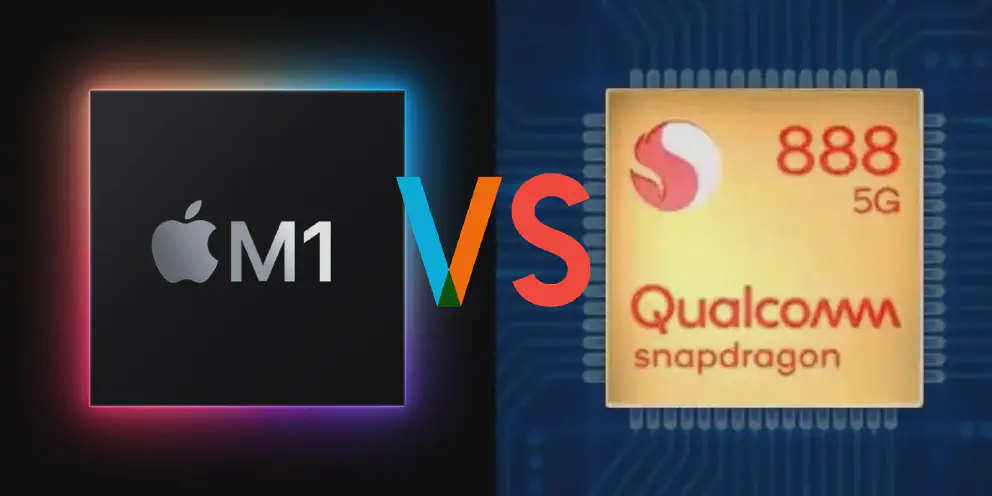Qualcomm Snapdragon 888 (888 from here on) and Apple M1 (M1 from here on) processors are CPU designed by respective companies that implements the ARM v8.0 ISA. While both implement the same instruction set, the internal design is totally different to suit their particular needs. One might say that comparing a mobile chip and a laptop chip is not fair, remember that the Snapdragon will be on a Samsung Galaxy Tablet S8 and the M1 is on the new 2021 iPad Pro. Get ready for a bloodbath.
Apple M1: General Info
The M1 is Apple’s first processor designed for laptops and desktop. It is a superset of the A14 processor which is used for iPhone 12 lineup. It has 8 cores (4 high-performance and 4 high-efficency cores). It has 7 or 8 graphic cores (depending configuration), 16-core neural engine plus secure enclave. Everything is connected via Apple Fabric which connects the I/O with a unified memory architecture.
Qualcomm Snapdragon 888: General Info
The snapdragon is the successor 860 / 870. 8 is consider as luck in Chinese culture and 888 means extremely lucky. 888 means that you have a smooth journey in life. That being said, the 888 is designed for phones and tablet where efficiency in priority. It has 1 very high performance core (called primary core), 3 high performance cores and 4 high efficiency core.
For graphics, it uses Adreno 680 graphics core and Hexagon Processor for Digital Signal processing (which helps with encoding videos / audio codecs). The Spectra 580 handles Image signaling (for camera and computational photography) and have other modules to handle security,sensor and I/O. Just like Apple, it has unified memory.
Architectural differences
The major difference between those chips is the targeted usage of said chip. The M1 is targeted as a desktop / laptop chips with higher power draw and in some cases, active cooling present. The 888 is designed for phones which means power draw efficiency is the main focus. It also expected the 888 chassis would only have passive cooling. Because of this, the M1 is designed to be performance first while the 888 is designed to be efficiency first.
Since the M1 is helping Apple transitioning Intel x86 to M1 ARM ISA, it has some x86 instructions sets to help with the performance when running old x86 binaries in translation mode. It means that instead of transforming every x86 instructions to ARM instruction, the M1 just process some x86 instruction directly with out translating. the Snapdragon does not do this because in most environment, it does not have this situation.
Another major difference is how they implement the graphic core, secure enclave and I/O. Both solution is propriety with the key difference is the 888 is more open in the sense many vendor can implement in their solution. Meanwhile, Apple has tight control of the drivers in which developers can only utilize the chip at higher levels only, and in Apple environment (macOS) only.
I/O is something that differs between those two chips. The 888 might have a powerful graphics chip, but it is not expected to output anything more than a high density display. Meanwhile, the M1 can output to two external display and one of the display is a 6K display. A huge feat considering that you are consistently outputting a 20MP simulated image at 60 times per second. And have room to display another 4K signal at 60Hz. A phone might expected to get all info wirelessly, a laptop chip is also expected to get and process signals from other ports like USB4 (40GB/s) and also network (1GB/s).
Benchmarks
Since one is a laptop CPU while the other is a phone CPU, they are not directly compared, but there are some common benchmark available.
In Geekbench 5, the M1 basically wallop the Snapdragon 888 in performance benchmark, this is not surprising since the M1 has more TDP and it is actively cooled while the 888 is just air-cooled and expected to run on a phone. A more fair comparison is between the A14 and the 888 which are both phone SOCs.
From the test, Snapdragon wins in some test while languish in others. RAW CPU performance is still better on the A14 while the 888 has better graphic performance.
Conclusion
Comparing the Snapdragon 888 and the M1 is like comparing a Mini and Honda Civic. Both can get to the destination around the same time, but one can carry more stuff and is more practical. Both the snapdragon 888 and Apple M1 is the marvel of semiconducting technology, but both have different applications in mind. Of course the M1 will pound the 888 in RAW power but the 888 will be more efficient for the task that is given.
Benchmark can be found at CPU Monkey

Snapdragon 888 vs A14 Bionic Comparison: Architecture, Benchmark and Ecosystem
Qualcomm vs Apple. The latest and greatest mobile chips from Cupertino and San Diego. Which one will prevail in the never ending competition to greatness?
Plug
Support this free website by visiting my Amazon affiliate links. Any purchase you make will give me a cut without any extra cost to you
- Mac Mini M1 - Amazon USA / Amazon UK
- iMac 24" M1 - Amazon USA / Amazon UK
- Mac Studio - Amazon USA
- MacBook Air M1 - Amazon USA / Amazon UK
- MacBook Pro 13" M1 - Amazon USA / Amazon UK
- MacBook Pro 14" M1 Pro / M1 Max - Amazon USA / Amazon UK
- MacBook Pro 16" M1 Pro / M1 Max - Amazon USA / Amazon UK
- Accessories:-
- Wireless earphones / headphones:-
- AirPods - Amazon USA / Amazon UK
- AirPods Pro - Amazon USA / Amazon UK
- AirPods Max - Amazon USA / Amazon UK
- Buyer's Guide:-
